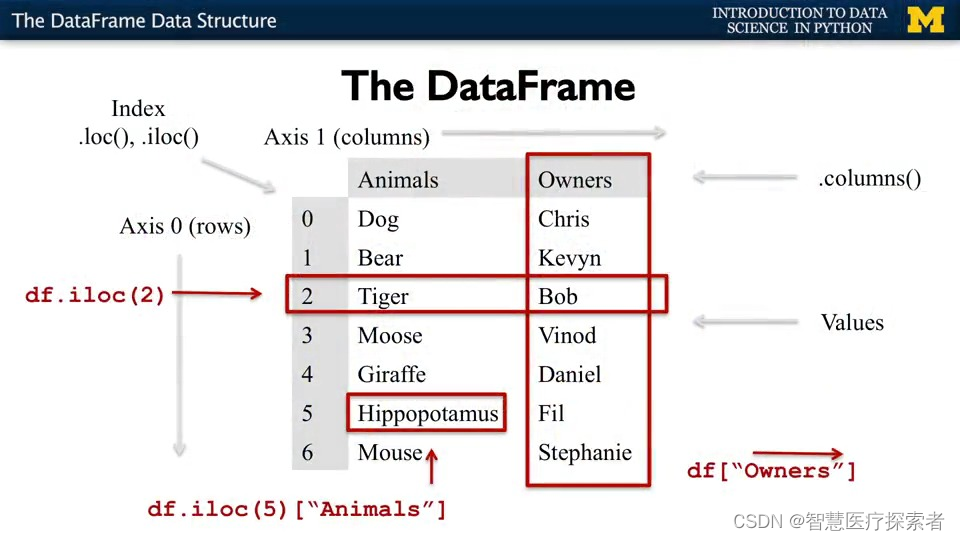
数据分析三剑客之一:Pandas详解与实战
Pandas 是一个开源的第三方 Python 库,从 Numpy 和 Matplotlib 的基础上构建而来,享有数据分析“三剑客之一”的盛名(NumPy、Matplotlib、Pandas)。Pandas 已经成为 Python 数据分析的必备高级工具,它的目标是成为强大、灵活、可以支持任何编程语言的数据分析工具。
目录
3.2.13 DataFrame属性方法info(),index,coloumns,values ,axes
3.2.14 head()&tail()查看DataFrame数据
3.2.17 ndim&shape查看DataFrame维数和维度
3.2.19 T(Transpose)对DataFrame转置
3.4.1 以 (row_index,row) 的形式遍历行iterrows():
3.4.2 使用已命名元组的方式遍历行itertuples()
3.5.1 axis=0, ascending=True 默认按“行标签”升序排列
1 Pandas介绍
Pandas 是一个开源的第三方 Python 库,从 Numpy 和 Matplotlib 的基础上构建而来,享有数据分析“三剑客之一”的盛名(NumPy、Matplotlib、Pandas)。Pandas 已经成为 Python 数据分析的必备高级工具,它的目标是成为强大、灵活、可以支持任何编程语言的数据分析工具。Pandas具有如下特点:
- DataFrame是一种高效快速的数据结构模式,Pandas支持DataFrame格式,从而可以自定义索引
- 可以将不同格式的数据文件加载到内存中
- 未对齐及其索引方式不同的数据可按轴自动对齐
- 可处理时间序列或非时间序列数据
- 可基于标签来切片索引,获得大数据集子集
- 可进行高性能数据分组、聚合、添加、删除
- 灵活处理数据缺失、重组、空格
Pandas广泛用于金融、经济、数据分析、统计等商业领域,为各个领域数据从业者提供了便捷。
官网地址:https://pandas.pydata.org/
2 Pandas的安装与导入
2.1 Pandas模块安装
Python自带的包管理工具pip来安装:
pip install pandas2.2 Pandas模块导入
Pandas的导入
import pandas as pd
import numpy as np # pandas和numpy常常结合在一起使用3 pandas数据结构及函数
构建和处理二维、多维数组是一项繁琐的任务。Pandas 为解决这一问题, 在 ndarray 数组(NumPy 中的数组)的基础上构建出了两种不同的数据结构,分别是 Series(一维数据结构)和 DataFrame(二维数据结构):
- Series 是带标签的一维数组,这里的标签可以理解为索引,但这个索引并不局限于整数,它也可以是字符类型,比如 a、b、c 等;
- DataFrame 是一种表格型数据结构,它既有行标签,又有列标签。
| 数据结构 | 维度 | 说明 |
| Series | 1 | 该结构能够存储各种数据类型,比如字符数、整数、浮点数、Python 对象等,Series 用 name 和 index 属性来描述 数据值。Series 是一维数据结构,因此其维数不可以改变。 |
| DataFrame | 2 | DataFrame 是一种二维表格型数据的结构,既有行索引,也有列索引。行索引是 index,列索引是 columns。 在创建该结构时,可以指定相应的索引值。 |
3.1 Series结构
Series 结构,也称Series序列,是Pandas常用的数据结构之一,它是一种类似于一维数组的结构,由一组数据值(value)和一组标签组成,其中标签与数据值之间是一一对应的关系。
Series 可以保存任何数据类型,比如整数、字符串、浮点数、Python 对象等,它的标签默认为整数,从 0 开始依次递增。Series 的结构图,如下所示:

通过标签我们可以更加直观地查看数据所在的索引位置。
函数原型:
pandas.Series( data, index, dtype, copy)参数说明:
#data 输入的数据,可以是列表、常量、ndarray 数组等。 #index 索引值必须是惟一的,如果没有传递索引,则默认为 #np.arrange(n)。 #dtype dtype表示数据类型,如果没有提供,则会自动判断得出。 #copy 表示对 data 进行拷贝,默认为 False。
可以用数组、字典、标量值或者 Python 对象来创建 Series 对象
Series 访问数据分为两种方式,一种是位置索引访问;另一种是标签索引访问。
Series 的常用属性和方法。在下表列出了 Series 对象的常用属性
| 名称 | 属性 |
| axes | 以列表的形式返回所有行索引标签 |
| dtype | 返回对象的数据类型 |
| empty | 判断Series对象是否为空 |
| ndim | 返回输入数据的维数 |
| size | 返回输入数据的元素数量 |
| values | 以ndarray的形式返回Series对象 |
| index | 返回一个RangeIndex对象,用来描述索引的取值范围。 |
3.1.1 ndarray创建Series对象
import pandas as pd
import numpy as np
data = np.array(['a', 'b', 'c', 'd'])
# 使用默认索引,创建 Series 序列对象
s1 = pd.Series(data)
print(f'默认索引:\n{s1}')
# 使用“显式索引”的方法自定义索引标签
s2 = pd.Series(data, index=[100, 101, 102, 103])
print(f'自定义索引\n{s2}')运行结果显示如下:
默认索引:
0 a
1 b
2 c
3 d
dtype: object
自定义索引
100 a
101 b
102 c
103 d
dtype: object示例中s1没有传递任何索引,所以索引默认从 0 开始分配 ,其索引范围为 0 到len(data)-1。
3.1.2 dict创建Series对象
把 dict 作为输入数据。如果没有传入索引时会按照字典的键来构造索引;反之,当传递了索引时需要将索引标签与字典中的值一一对应。
import pandas as pd
import numpy as np
data = {'a': 0, 'b': 1, 'c': 2}
# 没有传递索引时 会按照字典的键来构造索引
s1_dict = pd.Series(data)
print(f'没有传递索引\n{s1_dict}')
# 字典类型传递索引时 索引时需要将索引标签与字典中的值一一对应
# 当传递的索引值无法找到与其对应的值时,使用 NaN(非数字)填充
s2_dict = pd.Series(data, index=['a', 'b', 'c', 'd'])
print(f'传递索引\n{s2_dict}')运行结果显示如下:
没有传递索引
a 0
b 1
c 2
dtype: int64
传递索引
a 0.0
b 1.0
c 2.0
d NaN
dtype: float643.1.3 标量创建Series对象
import pandas as pd
import numpy as np
# 如果data是标量值,则必须提供索引: 标量值按照 index 的数量进行重复,并与其一一对应
s3 = pd.Series(6, index=[0,1,2,3])
print(f'标量值,则必须提供索引\n{s3}')运行结果显示如下:
标量值,则必须提供索引
0 6
1 6
2 6
3 6
dtype: int643.1.4 位置索引访问Series数据
import pandas as pd
s = pd.Series([1, 2, 3, 4, 5], index=['a', 'b', 'c', 'd', 'e'])
print(f'Series数据\n{s}')
# 位置索引 第一个位置索引:0
print(f'位置索引={s[0]}')
# 标签索引 第一个标签索引:a
print(f'标签索引={s["a"]}')#
# 通过切片的方式访问 Series 序列中的数据
print(f'前两个元素\n{s[:2]}')
print(f'最后三个元素\n{s[-3:]}')运行结果显示如下:
Series数据
a 1
b 2
c 3
d 4
e 5
dtype: int64
位置索引=1
标签索引=1
前两个元素
a 1
b 2
dtype: int64
最后三个元素
c 3
d 4
e 5
dtype: int643.1.5 标签索引访问Series数据
Series 类似于固定大小的 dict,把 index 中的索引标签当做 key,而把 Series 序列中的元素值当做 value,然后通过 index 索引标签来访问或者修改元素值。
import pandas as pd
s = pd.Series([1, 2, 3, 4, 5],index=['a', 'b', 'c', 'd', 'e'])
print(f'Series数据\n{s}')
# 标签索引访问单个元素
print(f'标签索引访问单个元素={s["a"]}')
# 标签索引访问多个元素
print(f'标签索引访问多个元素\n{s[["a","b","c"]]}')运行结果显示如下:
Series数据
a 1
b 2
c 3
d 4
e 5
dtype: int64
标签索引访问单个元素=1
标签索引访问多个元素
a 1
b 2
c 3
dtype: int64访问不包括的标签会抛出异常
3.1.6 Series常用属性axes
import pandas as pd
import numpy as np
s = pd.Series(np.random.randn(5))
print(f'默认索引\n{s}')
s1 = pd.Series(np.random.randn(5), index=['a', 'b', 'c', 'd', 'e'])
print(f'自定义索引\n{s1}')
# axes以列表的形式返回所有行索引标签
print(f'默认索引:{s.axes}')
print(f'自定义索引:{s1.axes}')运行结果显示如下:
默认索引
0 0.327024
1 0.679870
2 0.714354
3 -0.215886
4 -1.857184
dtype: float64
自定义索引
a -0.375701
b -1.400197
c -0.187348
d -0.853269
e 0.129702
dtype: float64
默认索引:[RangeIndex(start=0, stop=5, step=1)]
自定义索引:[Index(['a', 'b', 'c', 'd', 'e'], dtype='object')]3.1.7 Series常用属性index
import pandas as pd
import numpy as np
s = pd.Series(np.random.randn(5))
print(f'默认索引\n{s}')
s1 = pd.Series(np.random.randn(5), index=['a', 'b', 'c', 'd', 'e'])
print(f'自定义索引\n{s1}')
# index返回一个RangeIndex对象,用来描述索引的取值范围
print(f'默认索引:{s.index}')
#
print(f'自定义索引:{s1.index}')
# 通过.index.values 获取索引列表
print(s.index.values)
print(s1.index.values)运行结果显示如下:
默认索引
0 0.200998
1 0.469934
2 0.096422
3 -0.399627
4 0.783720
dtype: float64
自定义索引
a -1.639293
b -0.128694
c -0.940741
d -1.547780
e 0.670969
dtype: float64
默认索引:RangeIndex(start=0, stop=5, step=1)
自定义索引:Index(['a', 'b', 'c', 'd', 'e'], dtype='object')
[0 1 2 3 4]
['a' 'b' 'c' 'd' 'e']
3.1.8 Series常用属性values
import pandas as pd
import numpy as np
s = pd.Series(np.random.randn(5))
print(f'默认索引\n{s}')
# values以数组的形式返回Series对象中的数据。
print(s.values)运行结果显示如下:
默认索引
0 -0.772736
1 -0.473425
2 -0.588307
3 0.723052
4 0.601033
dtype: float64
[-0.77273598 -0.47342456 -0.5883065 0.72305156 0.60103283]
3.2 DataFrame结构
DataFrame一个表格型的数据结构,既有行标签(index),又有列标签(columns),它也被称异构数据表,所谓异构,指的是表格中每列的数据类型可以不同,比如可以是字符串、整型或者浮点型等。其结构图示意图,如下所示:

函数原型如下:
pandas.DataFrame( data, index, columns, dtype, copy)参数说明:
data 输入的数据,可以是 ndarray,series,list,dict,标量以及一个 DataFrame。 index 行标签,如果没有传递 index 值,则默认行标签是 np.arange(n),n 代表 data 的元素个数。 columns 列标签,如果没有传递 columns 值,则默认列标签是 np.arange(n)。 dtype dtype表示每一列的数据类型。 copy 默认为 False,表示复制数据 data。
DataFrame 的属性和方法,如下所示:
| 名称 | 属性&方法描述 |
| index | 返回行索引 |
| coloumns | 返回列索引 |
| values | 使用numpy数组表示Dataframe中的元素值 |
| head() | 返回前 n 行数据。 |
| tail() | 返回后 n 行数据。 |
| axes | 返回一个仅以行轴标签和列轴标签为成员的列表。 |
| dtypes | 返回每列数据的数据类型。 |
| empty | DataFrame中没有数据或者任意坐标轴的长度为0,则返回True。 |
| ndim | 轴的数量,也指数组的维数。 |
| shape | DataFrame中的元素数量。 |
| shift() | 将行或列移动指定的步幅长度 |
| T | 行和列转置。 |
| info() | 返回相关的信息:行数 列数,列索引 列非空值个数, 列类型 |
3.2.1 列表创建DataFame对象
import pandas as pd
# 单一列表创建 DataFrame
data = [1, 2, 3]
df1 = pd.DataFrame(data)
print(f'单一列表\n{df1}')
# 使用嵌套列表创建 DataFrame 对象
data = [['java', '10'], ['python', '20'], ['C++', '30']]
df2 = pd.DataFrame(data)
print(f'嵌套列表创建\n{df2}')
# 指定数值元素的数据类型为float: 并指定columns
df3 = pd.DataFrame(data, columns=['name', 'age'], dtype=(str, float))
print(f'指定数据类型和colums\n{df3}')运行结果显示如下:
单一列表
0
0 1
1 2
2 3
嵌套列表创建
0 1
0 java 10
1 python 20
2 C++ 30
指定数据类型和colums
name age
0 java 10
1 python 20
2 C++ 303.2.2 字典嵌套列表创建DataFrame对象
data字典中,键对应值的元素长度必须相等(也就是列表的长度相等),如果传递索引那么索引的长度必须等于列表的长度;如果没有传递索引,默认情况下 索引应为range(n)。n代表的列表的长度
import pandas as pd
data = {'Name': ['Tom', 'Jack', 'Steve', 'Ricky'], 'Age': [28, 34, 29, 42]}
df1 = pd.DataFrame(data)
print(f'默认索引\n{df1}')
df2 = pd.DataFrame(data, index=['a', 'b', 'c', 'd'])
print(f'自定义索引\n{df2}')运行结果显示如下:
默认索引
Name Age
0 Tom 28
1 Jack 34
2 Steve 29
3 Ricky 42
自定义索引
Name Age
a Tom 28
b Jack 34
c Steve 29
d Ricky 423.2.3 列表嵌套字典创建DataFrame对象
列表嵌套字典作为传入的值时,默认情况下 字典的键作为名(coloumns)
注意:如果某个元素的值缺失,也就是字典的key无法找到对应的Value,将使用NaN代替
import pandas as pd
# 字典的键被用作列名 如果其中某个元素值缺失,也就是字典的 key 无法找到对应的 value,将使用 NaN 代替。
data = [{'a': 1, 'b': 2}, {'a': 5, 'b': 10, 'c': 20}]
df1 = pd.DataFrame(data)
print(df1)
# 自定义行标签索引
df2 = pd.DataFrame(data, index=['first', 'second'])
print(df2)
# 如果列名 在字典键中不存在,所以对应值为 NaN。
df3 = pd.DataFrame(data, index=['first', 'second'], columns=['a', 'b'])
df4 = pd.DataFrame(data, index=['first', 'second'], columns=['a', 'b1'])
print(f'df3的列名在字典键中存在\n{df3}')
print(f'df4的列名b1在字典键不中存在\n{df4}')运行结果显示如下:
a b c
0 1 2 NaN
1 5 10 20.0
a b c
first 1 2 NaN
second 5 10 20.0
df3的列名在字典键中存在
a b
first 1 2
second 5 10
df4的列名b1在字典键不中存在
a b1
first 1 NaN
second 5 NaN3.2.4 Series创建DataFrame对象
传递一个字典形式的 Series,从而创建一个 DataFrame 对象,其输出结果的行索引是所有 index 的合集
import pandas as pd
# Series创建DataFrame对象 其输出结果的行索引是所有index的合集
data = {'one': pd.Series([1, 2, 3], index=['a', 'b', 'c']),
'two': pd.Series([1, 2, 3, 4], index=['a', 'b', 'c', 'd'])}
df = pd.DataFrame(data)
print(df)运行结果显示如下:
one two
a 1.0 1
b 2.0 2
c 3.0 3
d NaN 43.2.5 列索引选取DataFrame数据
DataFrame 可以使用列索引(columns index)来完成数据的选取、添加和删除操作
import pandas as pd
data = [['java', 10, 9], ['python', 20, 100], ['C++', 30, 50]]
df1 = pd.DataFrame(data, columns=['name', 'age', 'number'])
print(f'数据df1\n{df1}')
# 获取数据方式一:使用列索引,实现数据获取某一行数据 df[列名]等于df.列名
print(f'通过df1.name方式获取\n{df1.name}')
print(f'通过df1["name"]方式获取\n{df1["name"]}')
# 获取数据方式二:使用列索引,实现数据获取某多行数据 df[list]
print(f'通过df[list]方式获取多列数据\n{df1[["name","number"]]}')
# 获取数据方式三:使用布尔值筛选获取某行数据
# 不同的条件用()包裹起来,并或非分别使用&,|,~而非and,or,not
print(f'获取name=python的数据\n{df1[df1["name"]=="python"]}')
print(f'获取age大于等于20的数据\n{df1[df1["age"]>=20]}')
print(f'获取name=python的数据或者是age等于30\n{df1[(df1["name"]=="python") | (df1["age"]==30)]}')运行结果显示如下:
数据df1
name age number
0 java 10 9
1 python 20 100
2 C++ 30 50
通过df1.name方式获取
0 java
1 python
2 C++
Name: name, dtype: object
通过df1["name"]方式获取
0 java
1 python
2 C++
Name: name, dtype: object
通过df[list]方式获取多列数据
name number
0 java 9
1 python 100
2 C++ 50
获取name=python的数据
name age number
1 python 20 100
获取age大于等于20的数据
name age number
1 python 20 100
2 C++ 30 50
获取name=python的数据或者是age等于30
name age number
1 python 20 100
2 C++ 30 503.2.6 列索引添加DataFrame数据
使用 columns 列索引表标签可以实现添加新的数据列
import pandas as pd
# 列索引添加数据列
data = {'one': [1, 2, 3], 'two': [2, 3, 4]}
df1 = pd.DataFrame(data, index=['a', 'b', 'c'])
print(f'原数据\n{df1}')
# 方式一:使用df['列']=值,插入新的数据列
df1['three'] = pd.Series([10, 20, 30], index=list('abc'))
print(f'使用df["列"]=值,插入新的数据\n{df1}')
# 方式二:#将已经存在的数据列做相加运算
df1['four'] = df1['one']+df1['three']
print(f'将已经存在的数据列做相加运算\n{df1}')
# 方式三:使用 insert() 方法插入新的列
# 数值4代表插入到columns列表的索引位置
df1.insert(4, column='score', value=[50, 60, 70])
print(f'使用insert()方法插入\n{df1}')运行结果显示如下:
原数据
one two
a 1 2
b 2 3
c 3 4
使用df["列"]=值,插入新的数据
one two three
a 1 2 10
b 2 3 20
c 3 4 30
将已经存在的数据列做相加运算
one two three four
a 1 2 10 11
b 2 3 20 22
c 3 4 30 33
使用insert()方法插入
one two three four score
a 1 2 10 11 50
b 2 3 20 22 60
c 3 4 30 33 703.2.7 列索引删除DataFrame数据
通过del和pop()都能够删除DataFrame中的数据列
import pandas as pd
data = {'one': [1, 2, 3], 'two': [20, 30, 40], 'three': [20, 30, 40]}
df1 = pd.DataFrame(data, index=['a', 'b', 'c'])
print(f'原数据\n{df1}')
# 方式一 del 删除某一列
del df1["one"]
print(f'通过del df["列名"]删除\n{df1}')
# 方式er pop() 删除某一列
df1.pop("two")
print(f'通过pop("列名")删除\n{df1}')运行结果显示如下:
原数据
one two three
a 1 20 20
b 2 30 30
c 3 40 40
通过del df["列名"]删除
two three
a 20 20
b 30 30
c 40 40
通过pop("列名")删除
three
a 20
b 30
c 403.2.8 行标签索引选取DataFrame数据
可以将行标签传递给 loc 函数,来选取数据,loc 允许接两个参数分别是行和列,参数之间需要使用“逗号”隔开,但该函数只能接收标签索引。
import pandas as pd
data = {'one': [1, 2, 3, 4], 'two': [20, 30, 40, 50], 'three': [60, 70, 80, 90]}
df1 = pd.DataFrame(data, index=['a', 'b', 'c', 'd'])
print(f'原数据\n{df1}')
# 取某一行数据
print(f'取某一行数据\n{df1.loc["a"]}')
# loc允许接两个参数分别是行和列,参数之间需要使用“逗号”隔开,但该函数只能接收标签索引
# 获取某一个单元格的数据
print(f"取某一个单元格的数据\n{df1.loc['a','two']}")
# 更改某一个单元格的数据
df1.loc['a', 'two'] = 'abc'
print(f"更改后的数据\n{df1}")运行结果显示如下:
原数据
one two three
a 1 20 60
b 2 30 70
c 3 40 80
d 4 50 90
取某一行数据
one 1
two 20
three 60
Name: a, dtype: int64
取某一个单元格的数据
20
更改后的数据
one two three
a 1 abc 60
b 2 30 70
c 3 40 80
d 4 50 90
3.2.9 整数索引选取DataFrame数据
通过将数据行所在的索引位置传递给 iloc 函数,也可以实现数据行选取。iloc 允许接受两个参数分别是行和列,参数之间使用“逗号”隔开,但该函数只能接收整数索引。
import pandas as pd
data = {'one': [1, 2, 3, 4], 'two': [20, 30, 40, 50],'three': [60, 70, 80, 90]}
df1 = pd.DataFrame(data,index=['a', 'b', 'c', 'd'])
print(f'原数据\n{df1}')
# 取某一行的数据 索引是从0开始
print(f'取某一行的数据\n{df1.iloc[0]}')运行结果显示如下:
原数据
one two three
a 1 20 60
b 2 30 70
c 3 40 80
d 4 50 90
取某一行的数据
one 1
two 20
three 60
Name: a, dtype: int64
3.2.10 切片操作多行选取DataFrame数据
loc 允许接两个参数分别是行和列,参数之间需要使用“逗号”隔开,但该函数只能接收标签索引。
iloc 允许接受两个参数分别是行和列,参数之间使用“逗号”隔开,但该函数只能接收整数索引。
import pandas as pd
data = {'one': [1, 2, 3, 4], 'two': [20, 30, 40, 50], 'three': [60, 70, 80, 90]}
df1 = pd.DataFrame(data,index=['a', 'b', 'c', 'd'])
print(f'原数据\n{df1}')
# loc[] 允许接两个参数分别是行和列,参数之间需要使用“逗号”隔开,但该函数只能接收标签索引
print(f"#loc[]方式获取第三行最后两列数据\n{df1.loc['c','two':'three']}")
# iloc[] 允许接受两个参数分别是行和列,参数之间使用“逗号”隔开,但该函数只能接收整数索引。
print(f"#iloc[]方式获取第三行最后两列数据\n{df1.iloc[2,1:3]}")运行结果显示如下:
原数据
one two three
a 1 20 60
b 2 30 70
c 3 40 80
d 4 50 90
#loc[]方式获取第三行最后两列数据
two 40
three 80
Name: c, dtype: int64
#iloc[]方式获取第三行最后两列数据
two 40
three 80
Name: c, dtype: int643.2.11 添加DataFrame数据行
使用append()函数,可以将新的数据行添加到DataFrame中,该函数会在行末追加数据行
import pandas as pd
data = {'one': [1, 2, 3, 4], 'two': [20, 30, 40, 50], 'three': [60, 70, 80, 90]}
df1 = pd.DataFrame(data, index=['a', 'b', 'c', 'd'])
print(f'#原数据\n{df1}')
df2 = pd.DataFrame({'one': 'Q', 'two': 'W'}, index=['e'])
# 使用append()返回一个新的是DataFrame的对象
df = df1._append(df2)
print(f'#在行末追加新数据行\n{df}')运行结果显示如下:
#原数据
one two three
a 1 20 60
b 2 30 70
c 3 40 80
d 4 50 90
#在行末追加新数据行
one two three
a 1 20 60.0
b 2 30 70.0
c 3 40 80.0
d 4 50 90.0
e Q W NaN3.2.12 删除DataFrame数据行
可以使用行索引标签,从 DataFrame 中删除某一行数据。如果索引标签存在重复,那么它们将被一起删除
pop(行索引) 删除某一行
pop(列名) 删除某一列
注意:如果有重复的行索引并通过drop()会同时删除
import pandas as pd
data = {'one': [1, 2, 3, 4], 'two': [20, 30, 40, 50], 'three': [60, 70, 80, 90]}
df1 = pd.DataFrame(data,index=['a', 'b', 'c', 'd'])
print(f'原数据\n{df1}')
# pop(行索引) 删除某一行
df = df1.drop('a')
print(f'pop(行索引) 删除某一行\n{df}')
# pop(列名) 删除某一列
df1.pop("one")
print(f'#pop(列名) 删除某一列\n{df1}')运行结果显示如下:
原数据
one two three
a 1 20 60
b 2 30 70
c 3 40 80
d 4 50 90
pop(行索引) 删除某一行
one two three
b 2 30 70
c 3 40 80
d 4 50 90
#pop(列名) 删除某一列
two three
a 20 60
b 30 70
c 40 80
d 50 903.2.13 DataFrame属性方法info(),index,coloumns,values ,axes
- info():返回DataFrame对象的相关信息
- index:返回行索引
- coloumns:返回列索引
- values:使用numpy数组表示Dataframe中的元素值
- axes: 返回一个行标签、列标签组成的列表
import pandas as pd
data = {
'name:': pd.Series(['c语言中文网', "百度", '360搜索', '谷歌', 'Bing搜索', 'CSDN', '华为云']),
'year': pd.Series([5, 6, 15, 28, 3, 19, 23]),
'Rating': pd.Series([4.23, 3.24, 3.98, 2.56, 3.20, 4.6, 3.8])}
df = pd.DataFrame(data)
print(f'#原数据\n{df}')
# info() 获取相关信息
print(f'#df.info()获取DataFrame相关信息\n{df.info()}')
# index 获取行索引
print(f'#df.index 获取行索引\n{df.index}')
# coloumns 获取行索引
print(f'#df.columns 获取列索引\n{df.columns}')
# axes 获取行标签、列标签组成的列表
print(f'#df.axes 获取行标签、列标签组成的列表\n{df.axes}')
# values 使用numpy数组表示Dataframe中的元素值
print(f'#df.values获取Dataframe中的元素值\n{df.values}')运行结果显示如下:
#原数据
name: year Rating
0 c语言中文网 5 4.23
1 百度 6 3.24
2 360搜索 15 3.98
3 谷歌 28 2.56
4 Bing搜索 3 3.20
5 CSDN 19 4.60
6 华为云 23 3.80
<class 'pandas.core.frame.DataFrame'>
RangeIndex: 7 entries, 0 to 6
Data columns (total 3 columns):
# Column Non-Null Count Dtype
--- ------ -------------- -----
0 name: 7 non-null object
1 year 7 non-null int64
2 Rating 7 non-null float64
dtypes: float64(1), int64(1), object(1)
memory usage: 296.0+ bytes
#df.info()获取DataFrame相关信息
None
#df.index 获取行索引
RangeIndex(start=0, stop=7, step=1)
#df.columns 获取列索引
Index(['name:', 'year', 'Rating'], dtype='object')
#df.axes 获取行标签、列标签组成的列表
[RangeIndex(start=0, stop=7, step=1), Index(['name:', 'year', 'Rating'], dtype='object')]
#df.values获取Dataframe中的元素值
[['c语言中文网' 5 4.23]
['百度' 6 3.24]
['360搜索' 15 3.98]
['谷歌' 28 2.56]
['Bing搜索' 3 3.2]
['CSDN' 19 4.6]
['华为云' 23 3.8]]3.2.14 head()&tail()查看DataFrame数据
如果想要查看 DataFrame 的一部分数据,可以使用 head() 或者 tail() 方法。其中 head() 返回前 n 行数据,默认显示前 5 行数据
import pandas as pd
data = {
'name:': pd.Series(['c语言中文网', "百度", '360搜索', '谷歌', 'Bing搜索', 'CSDN', '华为云']),
'year': pd.Series([5, 6, 15, 28, 3, 19, 23]),
'Rating': pd.Series([4.23, 3.24, 3.98, 2.56, 3.20, 4.6, 3.8])}
df = pd.DataFrame(data)
print(f'#原数据\n{df}')
# head(n) 返回前n行数据 默认是前5行
print(f'#df.head(n) 返回前n行数据\n{df.head(2)}')
# tail(n) 返回后n行数据
print(f'#df.tail(n) 返回后n行数据\n{df.tail(2)}')运行结果显示如下:
#原数据
name: year Rating
0 c语言中文网 5 4.23
1 百度 6 3.24
2 360搜索 15 3.98
3 谷歌 28 2.56
4 Bing搜索 3 3.20
5 CSDN 19 4.60
6 华为云 23 3.80
#df.head(n) 返回前n行数据
name: year Rating
0 c语言中文网 5 4.23
1 百度 6 3.24
#df.tail(n) 返回后n行数据
name: year Rating
5 CSDN 19 4.6
6 华为云 23 3.83.2.15 dtypes查看DataFrame数据类型
返回每一列数据的类型
import pandas as pd
data = {
'name:': pd.Series(['c语言中文网', "百度", '360搜索', '谷歌', 'Bing搜索', 'CSDN', '华为云']),
'year': pd.Series([5, 6, 15, 28, 3, 19, 23]),
'Rating': pd.Series([4.23, 3.24, 3.98, 2.56, 3.20, 4.6, 3.8])}
df = pd.DataFrame(data)
print(f'#原数据\n{df}')
# dtpes 获取每一列数据的数据类型
print(f'#df.dtpes返回每一列的数据类型\n{df.dtypes}')运行结果显示如下:
#原数据
name: year Rating
0 c语言中文网 5 4.23
1 百度 6 3.24
2 360搜索 15 3.98
3 谷歌 28 2.56
4 Bing搜索 3 3.20
5 CSDN 19 4.60
6 华为云 23 3.80
#df.dtpes返回每一列的数据类型
name: object
year int64
Rating float64
dtype: object3.2.16 empty判断DataFrame是否为空
返回一个布尔值,判断输出的数据对象是否为空,若为 True 表示对象为空。
import pandas as pd
data = {
'name:': pd.Series(['c语言中文网', "百度", '360搜索', '谷歌', 'Bing搜索', 'CSDN', '华为云']),
'year': pd.Series([5, 6, 15, 28, 3, 19, 23]),
'Rating': pd.Series([4.23, 3.24, 3.98, 2.56, 3.20, 4.6, 3.8])}
df = pd.DataFrame(data)
print(f'#原数据\n{df}')
# empty 判断输出的数据对象是否为空,若为 True 表示对象为空
print(f'#df.empty 对象是否为空,若为 True 表示对象为空\n{df.empty}')运行结果显示如下:
#原数据
name: year Rating
0 c语言中文网 5 4.23
1 百度 6 3.24
2 360搜索 15 3.98
3 谷歌 28 2.56
4 Bing搜索 3 3.20
5 CSDN 19 4.60
6 华为云 23 3.80
#df.empty 对象是否为空,若为 True 表示对象为空
False3.2.17 ndim&shape查看DataFrame维数和维度
ndimf:返回数据对象的维数
shape:返回一个代表 DataFrame 维度的元组。返回值元组 (a,b),其中 a 表示行数,b 表示列数
import pandas as pd
data = {
'name:': pd.Series(['c语言中文网', "百度", '360搜索', '谷歌', 'Bing搜索', 'CSDN', '华为云']),
'year': pd.Series([5, 6, 15, 28, 3, 19, 23]),
'Rating': pd.Series([4.23, 3.24, 3.98, 2.56, 3.20, 4.6, 3.8])}
df = pd.DataFrame(data)
print(f'#原数据\n{df}')
# ndim 查看DataFrame的维数 同时也适合Series
print(f"#df.ndim 查看DataFrame的维数\n{df.ndim}")
# shape 维度的元组。返回值元组 (a,b),其中 a 表示行数,b 表示列数 同时也适合Series
print(f"#df.shape 维度的元组。返回值元组 (a,b),其中 a 表示行数,b 表示列数\n{df.shape}")运行结果显示如下:
#原数据
name: year Rating
0 c语言中文网 5 4.23
1 百度 6 3.24
2 360搜索 15 3.98
3 谷歌 28 2.56
4 Bing搜索 3 3.20
5 CSDN 19 4.60
6 华为云 23 3.80
#df.ndim 查看DataFrame的维数
2
#df.shape 维度的元组。返回值元组 (a,b),其中 a 表示行数,b 表示列数
(7, 3)
3.2.18 size查看DataFrame的元素数量
返回DataFrame对象的元素数量
import pandas as pd
data = {
'name:': pd.Series(['c语言中文网', "百度", '360搜索', '谷歌', 'Bing搜索', 'CSDN', '华为云']),
'year': pd.Series([5, 6, 15, 28, 3, 19, 23]),
'Rating': pd.Series([4.23, 3.24, 3.98, 2.56, 3.20, 4.6, 3.8])}
df = pd.DataFrame(data)
print(f'#原数据\n{df}')
# size查看DataFrame对象元素的数量
print(f'#df.size 查看DataFrame对象元素的数量\n{df.size}')运行结果显示如下:
#原数据
name: year Rating
0 c语言中文网 5 4.23
1 百度 6 3.24
2 360搜索 15 3.98
3 谷歌 28 2.56
4 Bing搜索 3 3.20
5 CSDN 19 4.60
6 华为云 23 3.80
#df.size 查看DataFrame对象元素的数量
213.2.19 T(Transpose)对DataFrame转置
import pandas as pd
data = {
'name:': pd.Series(['c语言中文网', "百度", '360搜索', '谷歌', 'Bing搜索', 'CSDN', '华为云']),
'year': pd.Series([5, 6, 15, 28, 3, 19, 23]),
'Rating': pd.Series([4.23, 3.24, 3.98, 2.56, 3.20, 4.6, 3.8])}
df = pd.DataFrame(data)
print(f'#原数据\n{df}')
# T(Transpose)转置 把行和列进行交换
print(f'#df.T把行和列进行交换\n{df.T}')运行结果显示如下:
#原数据
name: year Rating
0 c语言中文网 5 4.23
1 百度 6 3.24
2 360搜索 15 3.98
3 谷歌 28 2.56
4 Bing搜索 3 3.20
5 CSDN 19 4.60
6 华为云 23 3.80
#df.T把行和列进行交换
0 1 2 3 4 5 6
name: c语言中文网 百度 360搜索 谷歌 Bing搜索 CSDN 华为云
year 5 6 15 28 3 19 23
Rating 4.23 3.24 3.98 2.56 3.2 4.6 3.8
3.3 pandas描述性统计
描述统计学(descriptive statistics)是一门统计学领域的学科,主要研究如何取得反映客观现象的数据,并以图表形式对所搜集的数据进行处理和显示,最终对数据的规律、特征做出综合性的描述分析。Pandas 库正是对描述统计学知识完美应用的体现,可以说如果没有“描述统计学”作为理论基奠,那么 Pandas 是否存在犹未可知。下列表格对Pandas常用的统计学函数做了简单的总结:
| 函数名称 | 描述说明 |
|---|---|
| count() | 统计某个非空值的数量。 |
| sum() | 求和 |
| mean() | 求均值 |
| median() | 求中位数 |
| mode() | 求众数 |
| std() | 求标准差 |
| min() | 求最小值 |
| max() | 求最大值 |
| abs() | 求绝对值 |
| prod() | 求所有数值的乘积。 |
| cumsum() | 计算累计和,axis=0,按照行累加;axis=1,按照列累加。 |
| cumprod() | 计算累计积,axis=0,按照行累积;axis=1,按照列累积。 |
| corr() | 计算数列或变量之间的相关系数,取值-1到1,值越大表示关联性越强。 |
在 DataFrame 中,使用聚合类方法时需要指定轴(axis)参数。下面介绍两种传参方式:
- 对行操作,默认使用 axis=0 或者使用 "index";
- 对列操作,默认使用 axis=1 或者使用 "columns"。
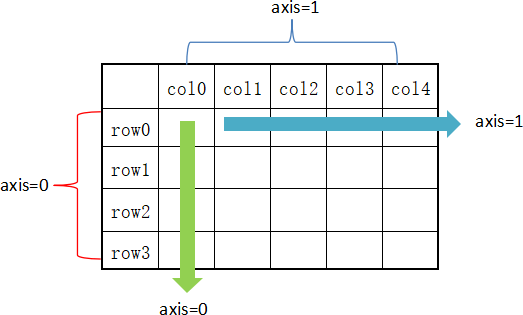
从图 上 可以看出,axis=0 表示按垂直方向进行计算,而 axis=1 则表示按水平方向。
如果想要应用自定义的函数,或者把其他库中的函数应用到 Pandas 对象中,有以下三种方法:
- 操作整个 DataFrame 的函数:pipe()
- 操作行或者列的函数:apply()
- 操作单一元素的函数:applymap()
3.3.1 垂直和水平方向的所有值求和
import pandas as pd
data = {
'name:': pd.Series(['c语言中文网', "百度", '360搜索', '谷歌', 'Bing搜索', 'CSDN', '华为云']),
'year': pd.Series([5, 6, 15, 28, 3, 19, 23]),
'Rating': pd.Series([4.23, 3.24, 3.98, 2.56, 3.20, 4.6, 3.8])}
df = pd.DataFrame(data)
print(f'#原数据\n{df}')
# sum() 默认返回axis=0 (垂直方向)的所有值的和
print(f'#df.sum() 默认返回axis=0(垂直方向)的所有值的和\n{df.sum()}')
df2 = pd.DataFrame(data, columns=['year', 'Rating'])
# sum() 当axis=1 (水平方向)的所有值的和
print(f'#df2.sum(axis=1) 默认返回axis=1 (水平方向)的所有值的和\n{df2.sum(axis=1)}')运行结果显示如下:
#原数据
name: year Rating
0 c语言中文网 5 4.23
1 百度 6 3.24
2 360搜索 15 3.98
3 谷歌 28 2.56
4 Bing搜索 3 3.20
5 CSDN 19 4.60
6 华为云 23 3.80
#df.sum() 默认返回axis=0(垂直方向)的所有值的和
name: c语言中文网百度360搜索谷歌Bing搜索CSDN华为云
year 99
Rating 25.61
dtype: object
#df2.sum(axis=1) 默认返回axis=1 (水平方向)的所有值的和
0 9.23
1 9.24
2 18.98
3 30.56
4 6.20
5 23.60
6 26.80
dtype: float64注意:sum() 和 cumsum() 函数可以同时处理数字和字符串数据。虽然字符聚合通常不被使用,但使用这两个函数并不会抛出异常;而对于 abs()、cumprod() 函数则会抛出异常,因为它们无法操作字符串数据。
3.3.2 mean()求均值
import pandas as pd
data = {
'year': pd.Series([5, 6, 15, 28, 3, 19, 23]),
'Rating': pd.Series([4.23, 3.24, 3.98, 2.56, 3.20, 4.6, 3.8])}
df = pd.DataFrame(data)
print(f'#原数据\n{df}')
# mean() 求平均值
print(f'#mean() 平均值\n{df.mean()}')运行结果显示如下:
#原数据
year Rating
0 5 4.23
1 6 3.24
2 15 3.98
3 28 2.56
4 3 3.20
5 19 4.60
6 23 3.80
#mean() 平均值
year 14.142857
Rating 3.658571
dtype: float643.3.3 std()求标准差
返回数值列的标准差,标准差是方差的算术平方根,它能反映一个数据集的离散程度。注意,平均数相同的两组数据,标准差未必相同。
import pandas as pd
data = {
'year': pd.Series([5, 6, 15, 28, 3, 19, 23]),
'Rating': pd.Series([4.23, 3.24, 3.98, 2.56, 3.20, 4.6, 3.8])}
df = pd.DataFrame(data)
print(f'#原数据\n{df}')
print(f'#df.std()求标准差\n{df.std()}')运行结果显示如下:
#原数据
year Rating
0 5 4.23
1 6 3.24
2 15 3.98
3 28 2.56
4 3 3.20
5 19 4.60
6 23 3.80
#df.std()求标准差
year 9.737018
Rating 0.698628
dtype: float643.3.4 自定义函数:操作整个数据表 pipe()
通过给 pipe() 函数传递一个自定义函数和适当数量的参数值,从而操作 DataFrme 中的所有元素。下面示例,实现了数据表中的元素值依次加 3
pip()传入函数对应的第一个位置上的参数必须是目标Series或DataFrame,其他相关的参数使用常规的键值对方式传入即可
import pandas as pd
import numpy as np
# 自定义函数
def adder(ele1, ele2):
return ele1+ele2
# 操作DataFrame
df = pd.DataFrame(np.random.randn(4, 3), columns=['c1', 'c2', 'c3'])
# 相加前
print(f'#原数据\n{df}')
# 相加后
print(f'#df.pipe()相加后的数据\n{df.pipe(adder,3)}')运行结果显示如下:
#原数据
c1 c2 c3
0 -0.374634 0.290875 0.021671
1 0.757403 0.218652 0.160206
2 -0.177390 -0.891544 -1.550597
3 -0.118167 -0.921873 0.890214
#df.pipe()相加后的数据
c1 c2 c3
0 2.625366 3.290875 3.021671
1 3.757403 3.218652 3.160206
2 2.822610 2.108456 1.449403
3 2.881833 2.078127 3.8902143.3.5 自定义函数:操作行或者列apply()
如果要操作 DataFrame 的某一行或者某一列,可以使用 apply() 方法,该方法与描述性统计方法类似,都有可选参数 axis。
import pandas as pd
import numpy as np
# 自定义函数
def adder(df, data):
data_list =[]
columns = df.index.values
for i in columns:
value = df[i]
data_list.append(value+data)
return np.sum(data_list, axis=0)
df = pd.DataFrame(np.random.randn(5, 3), columns=['col1', 'col2', 'col3'])
print(f'#原始数据\n{df}')
# axis=0默认按列操作,计算每一列均值
print(f'#df.apply(函数)计算每一列均值\n{df.apply(np.mean)}')
df = pd.DataFrame(np.random.randn(5,3),columns=['col1', 'col2', 'col3'])
print(f'#原始数据\n{df}')
# axis=1操作行,对指定行执行自定义函数
df['col4'] = df.apply(adder, args=(3,), axis=1)
print(f'#调用自定义函数\n{df}')运行结果显示如下:
#原始数据
col1 col2 col3
0 1.407879 -1.057357 -0.847865
1 0.389119 -1.620390 -1.269465
2 -0.740838 -0.699992 0.429402
3 -1.431036 1.091103 -0.757014
4 1.264738 -0.162598 0.253011
#df.apply(函数)计算每一列均值
col1 0.177973
col2 -0.489847
col3 -0.438386
dtype: float64
#原始数据
col1 col2 col3
0 1.056548 -0.064314 1.306463
1 0.485457 -0.067215 -1.634539
2 0.120638 -1.214249 0.135860
3 -1.293730 0.477338 -0.925762
4 0.053357 -1.766716 0.050723
#调用自定义函数
col1 col2 col3 col4
0 1.056548 -0.064314 1.306463 11.298697
1 0.485457 -0.067215 -1.634539 7.783704
2 0.120638 -1.214249 0.135860 8.042250
3 -1.293730 0.477338 -0.925762 7.257846
4 0.053357 -1.766716 0.050723 7.3373653.3.5 自定义函数:操作单一元素applymap()
DataFrame的 applymap() 函数可以对DataFrame里的每个值进行处理,然后返回一个新的DataFrame
import pandas as pd
df = pd.DataFrame({
'a': [1, 2, 3],
'b': [10, 20, 30],
'c': [5, 10, 15]
})
print(f'#原始数据\n{df}')
def add_one(x, data):
print(f'x的值 = {x}')
print(f'data的值={data}')
return x + 1
df1 = df.applymap(add_one, data=3)
print(f'#applymap()对每个元素操作后\n{df1}')运行结果显示如下:
#原始数据
a b c
0 1 10 5
1 2 20 10
2 3 30 15
x的值 = 1
data的值=3
x的值 = 2
data的值=3
x的值 = 3
data的值=3
x的值 = 10
data的值=3
x的值 = 20
data的值=3
x的值 = 30
data的值=3
x的值 = 5
data的值=3
x的值 = 10
data的值=3
x的值 = 15
data的值=3
#applymap()对每个元素操作后
a b c
0 2 11 6
1 3 21 11
2 4 31 163.4 pandas iteration遍历
如果想要遍历 DataFrame 的每一行,我们下列函数:
- iterrows():以 (row_index,row) 的形式遍历行;
- itertuples():使用已命名元组的方式遍历行。
3.4.1 以 (row_index,row) 的形式遍历行iterrows():
该方法按行遍历,返回一个迭代器,以行索引标签为键,以每一行数据为值。
import pandas as pd
import numpy as np
df = pd.DataFrame(np.random.randn(4, 3), columns=['col1', 'col2', 'col3'])
print(f'#原始数据\n{df}')
# iteritems():以键值对 (key,value) 的形式遍历 以列标签为键,以对应列的元素为值
for key, row in df.iterrows():
print(f'#key以列标签为键:{key}')
print(f'#row以对应列的元素为值\n{row}')运行结果显示如下:
#原始数据
col1 col2 col3
0 -0.968361 -0.980524 0.645811
1 -1.742061 -0.034852 1.625160
2 -0.152453 -0.186645 0.330469
3 0.837739 0.687838 -0.991223
#key以列标签为键:0
#row以对应列的元素为值
col1 -0.968361
col2 -0.980524
col3 0.645811
Name: 0, dtype: float64
#key以列标签为键:1
#row以对应列的元素为值
col1 -1.742061
col2 -0.034852
col3 1.625160
Name: 1, dtype: float64
#key以列标签为键:2
#row以对应列的元素为值
col1 -0.152453
col2 -0.186645
col3 0.330469
Name: 2, dtype: float64
#key以列标签为键:3
#row以对应列的元素为值
col1 0.837739
col2 0.687838
col3 -0.991223
Name: 3, dtype: float643.4.2 使用已命名元组的方式遍历行itertuples()
import pandas as pd
import numpy as np
df = pd.DataFrame(np.random.randn(4, 3), columns=['col1', 'col2', 'col3'])
print(f'#原始数据\n{df}')
for row in df.itertuples():
print(f'#每一行生成一个元组\n{row}')运行结果显示如下:
#原始数据
col1 col2 col3
0 -1.050943 1.098056 -0.858725
1 -0.348473 0.604341 0.249866
2 0.709212 -0.807796 -1.241162
3 -2.333712 -0.830910 -0.952756
#每一行生成一个元组
Pandas(Index=0, col1=-1.0509429373784085, col2=1.098055755892262, col3=-0.8587250615671127)
#每一行生成一个元组
Pandas(Index=1, col1=-0.34847318195598975, col2=0.604340877173634, col3=0.24986633604748865)
#每一行生成一个元组
Pandas(Index=2, col1=0.7092120669600998, col2=-0.8077962199969602, col3=-1.241162396630433)
#每一行生成一个元组
Pandas(Index=3, col1=-2.3337119180323316, col2=-0.8309096657807309, col3=-0.9527559438251861)3.5 pandas sorting排序
默认根据行标签对所有行排序,或根据列标签对所有列排序,或根据指定某列或某几列对行排序。
函数原型:
sort_index(axis=0, level=None, ascending=True,
inplace=False, kind='quicksort',
na_position='last', sort_remaining=True, by=None)参数说明:
axis: 0按照行名排序;1按照列名排序
level: 默认None,否则按照给定的level顺序排列---貌似并不是,文档
ascending: 默认True升序排列;False降序排列
inplace: 默认False,否则排序之后的数据直接替换原来的数据框
kind: 排序方法,{‘quicksort’, ‘mergesort’, ‘heapsort’}, default ‘quicksort’。似乎不用太关心。
na_position:缺失值默认排在最后{"first","last"}
by: 按照某一列或几列数据进行排序,但是by参数貌似不建议使用
3.5.1 axis=0, ascending=True 默认按“行标签”升序排列
import pandas as pd
df = pd.DataFrame({'b': [1, 2, 2, 3], 'a': [4, 3, 2, 1], 'c': [1, 3, 8, 2]}, index=[2, 0, 1, 3])
print(f'#原始数据\n{df}')
print(f'#默认按“行标签”升序排序,或df.sort_index(axis=0, ascending=True)\n{df.sort_index()}')运行结果显示如下:
#原始数据
b a c
2 1 4 1
0 2 3 3
1 2 2 8
3 3 1 2
#默认按“行标签”升序排序,或df.sort_index(axis=0, ascending=True)
b a c
0 2 3 3
1 2 2 8
2 1 4 1
3 3 1 23.5.2 axis=1 按“列标签”升序排列
import pandas as pd
df = pd.DataFrame({'b': [1, 2, 2, 3], 'a': [4, 3, 2, 1], 'c': [1, 3, 8, 2]}, index=[2, 0, 1, 3])
print(f'#原始数据\n{df}')
print(f'#按“列标签”升序排序,或df.sort_index(axis=1, ascending=True)\n{df.sort_index(axis=1)}')运行结果显示如下:
#原始数据
b a c
2 1 4 1
0 2 3 3
1 2 2 8
3 3 1 2
#按“列标签”升序排序,或df.sort_index(axis=1, ascending=True)
a b c
2 4 1 1
0 3 2 3
1 2 2 8
3 1 3 23.6 pandas去重函数
函数原型:
df.drop_duplicates(subset=['A','B','C'],keep='first',inplace=True)参数说明:
subset:表示要进去重的列名,默认为 None。 keep:有三个可选参数,分别是 first、last、False,默认为 first,表示只保留第一次出现的重复项,删除其余重复项,last 表示只保留最后一次出现的重复项,False 则表示删除所有重复项。 inplace:布尔值参数,默认为 False 表示删除重复项后返回一个副本,若为 Ture 则表示直接在原数据上删除重复项。
3.6.1 保留第一次出现的行重复项
import pandas as pd
data = {
'A': [1, 0, 1, 1],
'B': [0, 2, 5, 0],
'C': [4, 0, 4, 4],
'D': [1, 0, 1, 1]
}
df = pd.DataFrame(data)
print(f'#原始数据\n{df}')
# 默认是keep=first 保留第一次出现的重复项 inplace=False 删除后返回一个副本
df_drop = df.drop_duplicates()
print(f'#去重后的数据\n{df_drop}')
# 也可以使用以下参数
df_drop = df.drop_duplicates(keep='first', inplace=False)
print(f'#去重后的数据2\n{df_drop}')运行结果显示如下:
#原始数据
A B C D
0 1 0 4 1
1 0 2 0 0
2 1 5 4 1
3 1 0 4 1
#去重后的数据
A B C D
0 1 0 4 1
1 0 2 0 0
2 1 5 4 1
#去重后的数据2
A B C D
0 1 0 4 1
1 0 2 0 0
2 1 5 4 13.6.2 keep=False删除所有行重复项
import pandas as pd
data = {
'A': [1, 0, 1, 1],
'B': [0, 2, 5, 0],
'C': [4, 0, 4, 4],
'D': [1, 0, 1, 1]
}
df = pd.DataFrame(data)
print(f'#原始数据\n{df}')
# keep=False 删除所有重复项(行) inplace=True 在原始的数据进行删除重复项(行)
df.drop_duplicates(keep=False, inplace=True)
print(f'#去重后的数据\n{df}')运行结果显示如下:
#原始数据
A B C D
0 1 0 4 1
1 0 2 0 0
2 1 5 4 1
3 1 0 4 1
#去重后的数据
A B C D
1 0 2 0 0
2 1 5 4 13.6.3 subset删除指定的单列去重
import pandas as pd
data = {
'A': [1, 0, 1, 1],
'B': [0, 2, 5, 0],
'C': [4, 0, 4, 4],
'D': [1, 0, 1, 1]
}
df = pd.DataFrame(data)
print(f'#原始数据\n{df}')
# subset:表示要进去重的列名,默认为 None。
# 去除所有重复项,对于B列来说两个0是重复项
df_drop = df.drop_duplicates(subset=['B'], inplace=False, keep=False)
# 简写,省去subset参数
# df.drop_duplicates(['B'],keep=False)
print(f'#删除指定的列\n{df_drop}')
# reset_index() 函数会直接使用重置后的索引,索引从0开始
df_reset = df_drop.reset_index(drop=True)
print(f'重新设置行索引后的数据\n{df_reset}')运行结果显示如下:
#原始数据
A B C D
0 1 0 4 1
1 0 2 0 0
2 1 5 4 1
3 1 0 4 1
#删除指定的列
A B C D
1 0 2 0 0
2 1 5 4 1
重新设置行索引后的数据
A B C D
0 0 2 0 0
1 1 5 4 1删除重复项后,行标签使用的数字是原来的,并没有从 0 重新开始,Pandas 提供的 reset_index() 函数会直接使用重置后的索引。
3.6.4 subset指定多列同时去重
import pandas as pd
df = pd.DataFrame({'C_ID': [1, 1, 2, 12, 34, 23, 45, 34, 23, 12, 2, 3, 4, 1],
'Age': [12, 12, 15, 18, 12, 25, 21, 25, 25, 18, 25,12,32,18],
'G_ID': ['a', 'a', 'c', 'a', 'b', 's', 'd', 'a', 'b', 's', 'a', 'd', 'a', 'a']})
print(f'#原始数据\n{df}')
# last只保留最后一个重复项 去除重复项后并不更改行索引
df_drop = df.drop_duplicates(['Age', 'G_ID'], keep='last')
print(f'#去除指定多列的数据\n{df_drop}')运行结果显示如下:
#原始数据
C_ID Age G_ID
0 1 12 a
1 1 12 a
2 2 15 c
3 12 18 a
4 34 12 b
5 23 25 s
6 45 21 d
7 34 25 a
8 23 25 b
9 12 18 s
10 2 25 a
11 3 12 d
12 4 32 a
13 1 18 a
#去除指定多列的数据
C_ID Age G_ID
1 1 12 a
2 2 15 c
4 34 12 b
5 23 25 s
6 45 21 d
8 23 25 b
9 12 18 s
10 2 25 a
11 3 12 d
12 4 32 a
13 1 18 a
3.7 Pandas缺失值处理
3.7.1 检查缺失值
为了使检测缺失值变得更容易,Pandas 提供了 isnull() 和 notnull() 两个函数,它们同时适用于 Series 和 DataFrame对象
isnull() 判断是缺失值 若是则返回True ,反之返回False
import pandas as pd
import numpy as np
df = pd.DataFrame(np.random.randn(3, 3), index=list("ace"), columns=['one', 'two', 'three'])
print(f'原始数据\n{df}')
# 通过使用reindex(重构索引),创建了一个存在缺少值的 DataFrame对象
df = df.reindex(['a', 'b', 'c', 'd', 'e', 'f'])
print(f'#使用 reindex(重构索引)后的数据\n{df}')
# isnull() 检查是否是缺失值,若是则返回True 反之返回False
print(f'#isnull()判断第one列的每个元素是否是缺失值\n{df["one"].isnull()}')运行结果显示如下:
原始数据
one two three
a -0.946582 0.054540 0.586515
c 1.756336 0.082180 0.174922
e -2.136985 0.247677 -1.501012
#使用 reindex(重构索引)后的数据
one two three
a -0.946582 0.054540 0.586515
b NaN NaN NaN
c 1.756336 0.082180 0.174922
d NaN NaN NaN
e -2.136985 0.247677 -1.501012
f NaN NaN NaN
#isnull()判断第one列的每个元素是否是缺失值
a False
b True
c False
d True
e False
f True
Name: one, dtype: boolnotnull()判断不是缺失值 若不是缺失值则返回True,反之返回False
import pandas as pd
import numpy as np
df = pd.DataFrame(np.random.randn(3, 3), index=list("ace"), columns=['one', 'two', 'three'])
print(f'原始数据\n{df}')
# 通过使用 reindex(重构索引),创建了一个存在缺少值的 DataFrame对象
df = df.reindex(['a', 'b', 'c', 'd', 'e', 'f'])
print(f'#使用 reindex(重构索引)后的数据\n{df}')
# notnull() 检查是否不是缺失值,若不是则返回True 反之返回False
print(f'判断是第one列的每个元素是否不是缺失值\n{df["one"].notnull()}')运行结果显示如下:
原始数据
one two three
a -0.998457 1.810817 0.348848
c 1.831015 0.319635 0.903095
e -0.572937 1.237014 -0.093289
#使用 reindex(重构索引)后的数据
one two three
a -0.998457 1.810817 0.348848
b NaN NaN NaN
c 1.831015 0.319635 0.903095
d NaN NaN NaN
e -0.572937 1.237014 -0.093289
f NaN NaN NaN
判断是第one列的每个元素是否不是缺失值
a True
b False
c True
d False
e True
f False
Name: one, dtype: bool3.7.2 缺失数据计算
计算缺失数据时,需要注意两点:首先数据求和时,将 NA 值视为 0 ,其次,如果要计算的数据为 NA,那么结果就是 NA
import pandas as pd
import numpy as np
df = pd.DataFrame(np.random.randn(3, 3), index=list("ace"), columns=['one', 'two', 'three'])
print(f'#原始数据\n{df}')
# 通过使用 reindex(重构索引),创建了一个存在缺少值的 DataFrame对象
df = df.reindex(['a', 'b', 'c', 'd', 'e', 'f'])
print(f'#使用 reindex(重构索引)后的数据\n{df}')
# 计算缺失数据时,需要注意两点:首先数据求和时,将 NA 值视为 0 ,其次,如果要计算的数据为 NA,那么结果就是 NA
print(df['one'].sum())运行结果显示如下:
#原始数据
one two three
a 0.274570 -0.007715 -0.138648
c 0.428160 -0.878011 0.165583
e -0.338313 0.643098 -0.715703
#使用 reindex(重构索引)后的数据
one two three
a 0.274570 -0.007715 -0.138648
b NaN NaN NaN
c 0.428160 -0.878011 0.165583
d NaN NaN NaN
e -0.338313 0.643098 -0.715703
f NaN NaN NaN
0.36441717559237893.7.3 清理并填充缺失值
fillna()标量替换NaN
import pandas as pd
import numpy as np
df = pd.DataFrame(np.random.randn(3, 3), index=list("ace"), columns=['one', 'two', 'three'])
print(f'#原始数据\n{df}')
# 通过使用 reindex(重构索引),创建了一个存在缺少值的 DataFrame对象
df = df.reindex(['a', 'b', 'c', 'd', 'e', 'f'])
print(f'#使用 reindex(重构索引)后的数据\n{df}')
# 用fillna(6)标量替换NaN
print(f'用fillna(6)标量替换NaN后的数据\n{df.fillna(6)}')运行结果显示如下:
#原始数据
one two three
a 0.577051 1.152249 0.614189
c -1.957000 1.306602 -0.463318
e 0.103491 0.280445 -2.530827
#使用 reindex(重构索引)后的数据
one two three
a 0.577051 1.152249 0.614189
b NaN NaN NaN
c -1.957000 1.306602 -0.463318
d NaN NaN NaN
e 0.103491 0.280445 -2.530827
f NaN NaN NaN
用fillna(6)标量替换NaN后的数据
one two three
a 0.577051 1.152249 0.614189
b 6.000000 6.000000 6.000000
c -1.957000 1.306602 -0.463318
d 6.000000 6.000000 6.000000
e 0.103491 0.280445 -2.530827
f 6.000000 6.000000 6.000000ffill() 向前填充和 bfill() 向后填充,填充NA
import pandas as pd
import numpy as np
df = pd.DataFrame(np.random.randn(3, 3), index=list("ace"), columns=['one', 'two', 'three'])
print(f'#原始数据\n{df}')
# 通过使用 reindex(重构索引),创建了一个存在缺少值的 DataFrame对象
df = df.reindex(['a', 'b', 'c', 'd', 'e', 'f'])
print(f'#使用 reindex(重构索引)后的数据\n{df}')
print(f"#.fillna(method='ffill')向前填充后的数据\n{df.fillna(method='ffill')}")
print(f"#.bfillna()向后填充后的数据\n{df.bfill()}")运行结果显示如下:
#原始数据
one two three
a -0.480378 0.730596 -1.192572
c 0.651002 1.834280 1.179207
e 0.146290 -0.618078 2.782963
#使用 reindex(重构索引)后的数据
one two three
a -0.480378 0.730596 -1.192572
b NaN NaN NaN
c 0.651002 1.834280 1.179207
d NaN NaN NaN
e 0.146290 -0.618078 2.782963
f NaN NaN NaN
#.fillna(method='ffill')向前填充后的数据
one two three
a -0.480378 0.730596 -1.192572
b -0.480378 0.730596 -1.192572
c 0.651002 1.834280 1.179207
d 0.651002 1.834280 1.179207
e 0.146290 -0.618078 2.782963
f 0.146290 -0.618078 2.782963
#.bfillna()向后填充后的数据
one two three
a -0.480378 0.730596 -1.192572
b 0.651002 1.834280 1.179207
c 0.651002 1.834280 1.179207
d 0.146290 -0.618078 2.782963
e 0.146290 -0.618078 2.782963
f NaN NaN NaN3.7.4 使用replace替换通用值
在某些情况下,您需要使用 replace() 将 DataFrame 中的通用值替换成特定值,这和使用 fillna() 函数替换 NaN 值是类似的
import pandas as pd
df = pd.DataFrame({'one': [10, 20, 30, 40, 50, 10], 'two': [99, 0, 30, 40, 50, 60]})
print(f'#原始数据\n{df}')
df = df.replace({10: 100, 30: 333, 99: 9})
print(f'#replace替换后的数据\n{df}')运行结果显示如下:
#原始数据
one two
0 10 99
1 20 0
2 30 30
3 40 40
4 50 50
5 10 60
#replace替换后的数据
one two
0 100 9
1 20 0
2 333 333
3 40 40
4 50 50
5 100 603.7.5 删除缺失值
如果想删除缺失值,那么使用 dropna() 函数与参数 axis 可以实现。在默认情况下,按照 axis=0 来按行处理,这意味着如果某一行中存在 NaN 值将会删除整行数据
import pandas as pd
import numpy as np
df = pd.DataFrame(np.random.randn(3, 3), index=list("ace"), columns=['one', 'two', 'three'])
print(f'#原始数据\n{df}')
# 通过使用 reindex(重构索引),创建了一个存在缺少值的 DataFrame对象
df = df.reindex(['a', 'b', 'c', 'd', 'e', 'f'])
print(f'#使用 reindex(重构索引)后的数据\n{df}')
# dropna() axis=0如果某一行中存在 NaN 值将会删除整行数据
print(f'#dropna()删除后的数据\n{df.dropna()}')运行结果显示如下:
#原始数据
one two three
a -0.822900 0.025019 0.934275
c 0.215935 -0.634852 -1.236928
e -0.044390 0.464661 0.367780
#使用 reindex(重构索引)后的数据
one two three
a -0.822900 0.025019 0.934275
b NaN NaN NaN
c 0.215935 -0.634852 -1.236928
d NaN NaN NaN
e -0.044390 0.464661 0.367780
f NaN NaN NaN
#dropna()删除后的数据
one two three
a -0.822900 0.025019 0.934275
c 0.215935 -0.634852 -1.236928
e -0.044390 0.464661 0.3677803.8 pandas csv操作
使用pandas做数据处理的第一步就是读取数据,数据源可以来自于各种地方,csv文件便是其中之一。而读取csv文件,pandas也提供了非常强力的支持,参数有四五十个。这些参数中,有的很容易被忽略,但是在实际工作中却用处很大 。
3.8.1 read_csv()读取文件
函数原型:
pandas.read_csv(filepath_or_buffer, sep=',', delimiter=None,
header='infer',names=None, index_col=None,
usecols=None)index_col()自定义索引:在 CSV 文件中指定了一个列,然后使用index_col可以实现自定义索引
文件内容如下(test.csv):
ID,Name,Age,City,Salary
1,Jack,28,Beijing,22000
2,Lida,32,Shanghai,19000
3,John,43,Shenzhen,12000
4,Helen,38,Hengshui,3500import pandas as pd
# 读取csv文件数据 sep :指定分隔符。如果不指定参数,则会尝试使用逗号分隔
df = pd.read_csv('test.csv', sep=',')
print(f'#读取csv文件数据\n{df}')
# 使用index_col可以实现自定义索引
df = pd.read_csv('test.csv', index_col=['ID'])
print(f'使用index_col可以实现自定义索引\n{df}')
print(f'获取自定义的索引={df.index}')运行结果显示如下:
#读取csv文件数据
ID Name Age City Salary
0 1 Jack 28 Beijing 22000
1 2 Lida 32 Shanghai 19000
2 3 John 43 Shenzhen 12000
3 4 Helen 38 Hengshui 3500
使用index_col可以实现自定义索引
Name Age City Salary
ID
1 Jack 28 Beijing 22000
2 Lida 32 Shanghai 19000
3 John 43 Shenzhen 12000
4 Helen 38 Hengshui 3500
获取自定义的索引=Index([1, 2, 3, 4], dtype='int64', name='ID')3.8.2 names更改文件标头名
使用 names 参数可以指定头文件的名称
- 当names没被赋值时,header会变成0,即选取数据文件的第一行作为列名。
- 当 names 被赋值,header 没被赋值时,那么header会变成None。如果都赋值,就会实现两个参数的组合功能。
import pandas as pd
df = pd.read_csv('test.csv', sep=',')
print(f'#读取csv文件数据\n{df}')
# names更改文件标头名 header 没有赋值
df = pd.read_csv('test.csv', names=['a', 'b', 'c', 'd', 'e'])
print(f'#names 更改表头名\n{df}')运行结果显示如下:
#读取csv文件数据
ID Name Age City Salary
0 1 Jack 28 Beijing 22000
1 2 Lida 32 Shanghai 19000
2 3 John 43 Shenzhen 12000
3 4 Helen 38 Hengshui 3500
#names 更改表头名
a b c d e
0 ID Name Age City Salary
1 1 Jack 28 Beijing 22000
2 2 Lida 32 Shanghai 19000
3 3 John 43 Shenzhen 12000
4 4 Helen 38 Hengshui 3500注意:文件标头名是附加的自定义名称,原来的标头名(列标签名)并没有被删除,此时可以使用header参数来删除它
import pandas as pd
# names更改文件标头名 header为变成0,即选取文件的第一行作为表头
df = pd.read_csv("test.csv", names=['a', 'b', 'c', 'd', 'e'],header=0)
print(f'#names 更改表头名且header=0\n{df}')
df = pd.read_csv('test.csv',header=1)
# 不指定names,指定header为1,则选取第二行当做表头,第二行下面的是数据
print(f'#不指定names,指定header=1则选取第二行当做表头\n{df}')运行结果显示如下:
#names 更改表头名且header=0
a b c d e
0 1 Jack 28 Beijing 22000
1 2 Lida 32 Shanghai 19000
2 3 John 43 Shenzhen 12000
3 4 Helen 38 Hengshui 3500
#不指定names,指定header=1则选取第二行当做表头
1 Jack 28 Beijing 22000
0 2 Lida 32 Shanghai 19000
1 3 John 43 Shenzhen 12000
2 4 Helen 38 Hengshui 35003.8.3 skiprows跳过指定的行数
skiprows参数表示跳过指定的行数
import pandas as pd
df = pd.read_csv('test.csv', names=['a', 'b', 'c', 'd', 'e'], header=0)
print(f'#names 更改表头名且header=0\n{df}')
# skiprows指定跳过行数
df = pd.read_csv('test.csv', skiprows=2)
print(f'#skiprows指定跳过行数\n{df}')运行结果显示如下:
#names 更改表头名且header=0
a b c d e
0 1 Jack 28 Beijing 22000
1 2 Lida 32 Shanghai 19000
2 3 John 43 Shenzhen 12000
3 4 Helen 38 Hengshui 3500
#skiprows指定跳过行数
2 Lida 32 Shanghai 19000
0 3 John 43 Shenzhen 12000
1 4 Helen 38 Hengshui 35003.8.4 to_csv()转换数据
Pandas 提供的 to_csv() 函数用于将 DataFrame 转换为 CSV 数据。如果想要把 CSV 数据写入文件,只需向函数传递一个文件对象即可。否则,CSV 数据将以字符串格式返回。
import pandas as pd
data = {'Name': ['Smith', 'Parker'], 'ID': [101, 102], 'Language': ['Python', 'JavaScript']}
df_data = pd.DataFrame(data)
print(f'#DataFrame原始数据\n{df_data}')
# 通过to_csv()转成csv文件数据
df_csv = df_data.to_csv()
print(f'#通过to_csv()转成csv文件数据后的数据\n{df_csv}')
# 指定 CSV 文件输出时的分隔符,并将其保存在 pandas.csv 文件中index=False 表示不写入索引
df_data.to_csv("person.csv", sep='|', index=False)运行结果显示如下:
#DataFrame原始数据
Name ID Language
0 Smith 101 Python
1 Parker 102 JavaScript
#通过to_csv()转成csv文件数据后的数据
,Name,ID,Language
0,Smith,101,Python
1,Parker,102,JavaScript存储的person.csv文件:
Name|ID|Language
Smith|101|Python
Parker|102|JavaScript
3.9 pandas操作Excel
3.9.1 to_excel()数据转换
通过 to_excel() 函数可以将 Dataframe 中的数据写入到 Excel 文件。
如果想要把单个对象写入 Excel 文件,那么必须指定目标文件名;如果想要写入到多张工作表中,则需要创建一个带有目标文件名的ExcelWriter对象,并通过sheet_name参数依次指定工作表的名称。
函数原型:
DataFrame.to_excel(excel_writer, sheet_name='Sheet1',
na_rep='', float_format=None,
columns=None, header=True,
index=True, index_label=None,
startrow=0, startcol=0, engine=None,
merge_cells=True, encoding=None,
inf_rep='inf', verbose=True, freeze_panes=None) 常用参数说明:
| 参数名称 | 描述说明 |
|---|---|
| excel_wirter | 文件路径或者 ExcelWrite 对象。 |
| sheet_name | 指定要写入数据的工作表名称。 |
| na_rep | 缺失值的表示形式。 |
| float_format | 它是一个可选参数,用于格式化浮点数字符串。 |
| columns | 指要写入的列。 |
| header | 写出每一列的名称,如果给出的是字符串列表,则表示列的别名。 |
| index | 表示要写入的索引。 |
| index_label | 引用索引列的列标签。如果未指定,并且 hearder 和 index 均为为 True,则使用索引名称。如果 DataFrame 使用 MultiIndex,则需要给出一个序列。 |
| startrow | 初始写入的行位置,默认值0。表示引用左上角的行单元格来储存 DataFrame。 |
| startcol | 初始写入的列位置,默认值0。表示引用左上角的列单元格来储存 DataFrame。 |
| engine | 它是一个可选参数,用于指定要使用的引擎,可以是 openpyxl 或 xlsxwriter。 |
创建表格并写入数据
import pandas as pd
# 创建DataFrame数据
info_website = pd.DataFrame({'name': ['博客中国', 'c语言中文网', 'CSDN', '92python'],
'rank': [1, 2, 3, 4],
'language': ['PHP', 'C', 'PHP', 'Python']})
print(f'#DataFrame数据\n{info_website}')
# 创建ExcelWrite对象
to_excle_file_path = 'test_excel.xlsx'
writer = pd.ExcelWriter(to_excle_file_path)
info_website.to_excel(writer)
writer.close()运行结果显示如下:
#DataFrame数据
name rank language
0 博客中国 1 PHP
1 c语言中文网 2 C
2 CSDN 3 PHP
3 92python 4 Pythontest_excel.xlsx内容如下:
| name | rank | language | |
| 0 | 博客中国 | 1 | PHP |
| 1 | c语言中文网 | 2 | C |
| 2 | CSDN | 3 | PHP |
| 3 | 92python | 4 | Python |
使用pd.ExcelWriter生成writer,然后就可将数据写入该excel文件了,但是写完之后必须要writer.close(),否则数据仍然只在数据流中,并没保存到excel文件中。
3.9.2 一次性插入多个sheet数据
注意:此操作会将原文件内容覆盖掉
import pandas as pd
to_excle_file_path = 'test_excel2.xlsx'
# 创建DataFrame数据 字典嵌套数组类型
info_website = pd.DataFrame({'name': ['博客中国', 'c语言中文网', 'CSDN', '92python'],
'rank': [1, 2, 3, 4],
'language': ['PHP', 'C', 'PHP', 'Python']})
print(f'#DataFrame数据\n{info_website}')
# 数组嵌套字典类型
data = [{'a': 1, 'b': 2, 'c': 3},
{'a': 5, 'b': 10, 'c': 20},
{'a': "王者", 'b': '黄金', 'c': '白银'}]
df = pd.DataFrame(data)
print(f'#DataFrame数据\n{df}')
writer = pd.ExcelWriter(to_excle_file_path)
df.to_excel(writer)
info_website.to_excel(writer, sheet_name="这是第一个sheet", index=False)
info_website.to_excel(writer, sheet_name="这是第二个sheet", index=False)
writer.close()运行结果显示如下:
#DataFrame数据
name rank language
0 博客中国 1 PHP
1 c语言中文网 2 C
2 CSDN 3 PHP
3 92python 4 Python
#DataFrame数据
a b c
0 1 2 3
1 5 10 20
2 王者 黄金 白银保存的文件内容如下:
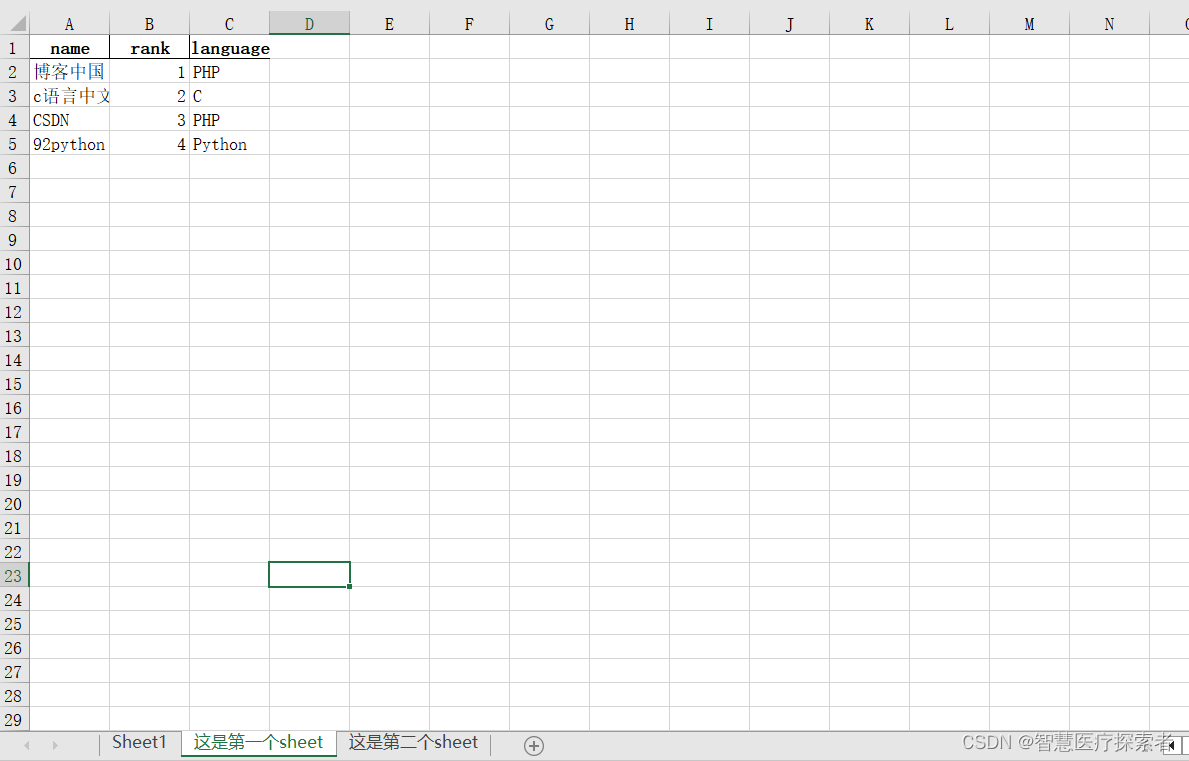
3.9.3 追加sheet表内容
import pandas as pd
to_excle_file_path = 'test_excel2.xlsx'
# 创建DataFrame数据 字典嵌套数组类型
info_website = pd.DataFrame({'name': ['博客中国', 'c语言中文网', 'CSDN', '92python'],
'rank': [1, 2, 3, 4],
'language': ['PHP', 'C', 'PHP', 'Python']})
print(f'#DataFrame数据\n{info_website}')
# 数组嵌套字典类型
data = [{'a': 1, 'b': 2, 'c': 3},
{'a': 5, 'b': 10, 'c': 20},
{'a': "王者", 'b': '黄金', 'c': '白银'}]
df = pd.DataFrame(data)
print(f'#DataFrame数据\n{df}')
writer = pd.ExcelWriter(to_excle_file_path, mode='a', engine='openpyxl')
df.to_excel(writer, sheet_name="追加第一个sheet", index=False)
info_website.to_excel(writer, sheet_name="追加第二个sheet", index=False)
info_website.to_excel(writer, sheet_name="追加第三个sheet", index=False)
writer.close()运行结果显示如下:
#DataFrame数据
name rank language
0 博客中国 1 PHP
1 c语言中文网 2 C
2 CSDN 3 PHP
3 92python 4 Python
#DataFrame数据
a b c
0 1 2 3
1 5 10 20
2 王者 黄金 白银Excel内容写入后如下:
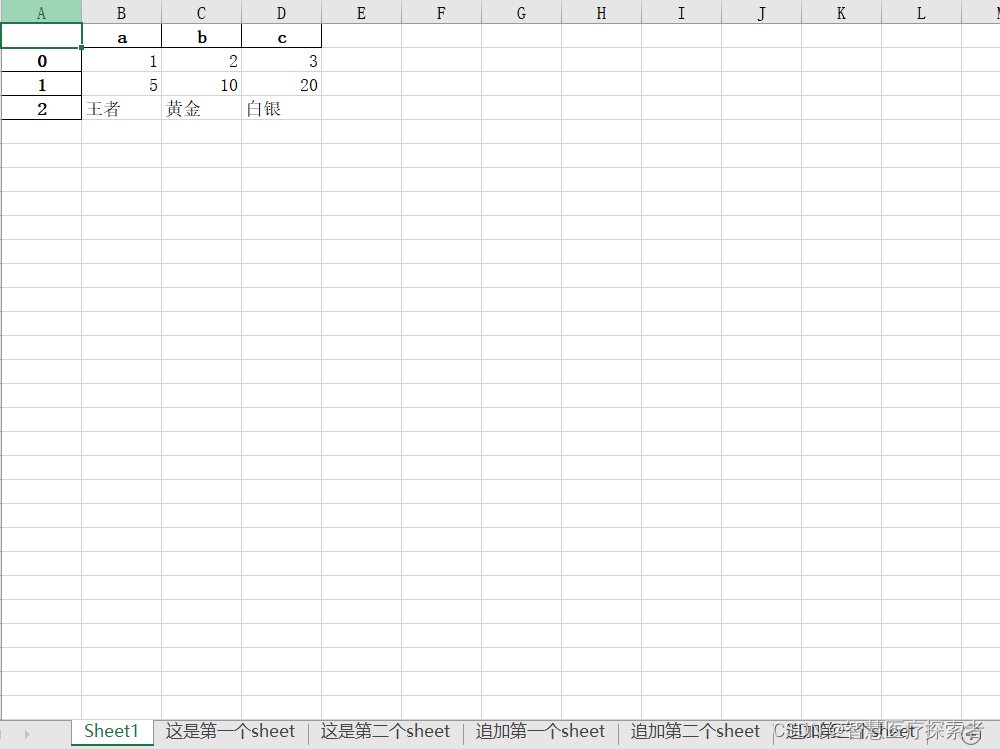
3.9.4 read_excel()读取数据
可以使用 read_excel() 方法读取 Excel 表格中的数据,其语法格式如下:
pandas.read_excel(io, sheet_name=0, header=0, names=None, index_col=None,
usecols=None, squeeze=False,dtype=None, engine=None,
converters=None, true_values=None, false_values=None,
skiprows=None, nrows=None, na_values=None, parse_dates=False,
date_parser=None, thousands=None, comment=None, skipfooter=0,
convert_float=True, **kwds)常用参数如下:
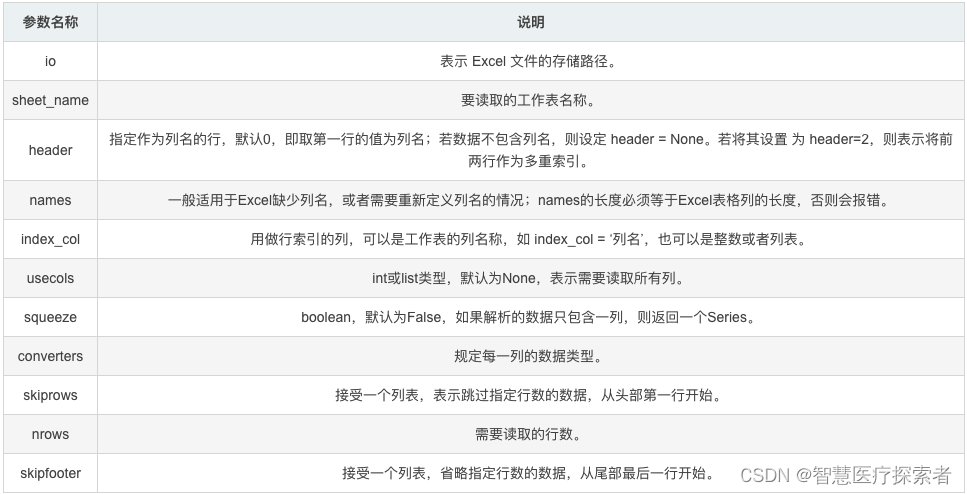
处理未命名的列以及重新定义索引
import pandas as pd
#读取excel数据
file_path = 'test_excel.xlsx'
df = pd.read_excel(file_path, engine='openpyxl')
print(f'#原始数据\n{df}')
# 选择name列做为索引,并跳过前两行
df = pd.read_excel(file_path, index_col='name', skiprows=[2], engine='openpyxl')
print(f'#选择name列做为索引,并跳过前两行\n{df}')
# 处理未命名列
df.columns = df.columns.str.replace('Unnamed.*', 'col_label')
print(f'#修改为未命名的列\n{df}')运行结果显示如下:
#原始数据
Unnamed: 0 name rank language
0 0 博客中国 1 PHP
1 1 c语言中文网 2 C
2 2 CSDN 3 PHP
3 3 92python 4 Python
#选择name列做为索引,并跳过前两行
Unnamed: 0 rank language
name
博客中国 0 1 PHP
CSDN 2 3 PHP
92python 3 4 Python
#修改为未命名的列
Unnamed: 0 rank language
name
博客中国 0 1 PHP
CSDN 2 3 PHP
92python 3 4 Python
index_col前多列作为索引列,usecols设置读取的数据列
import pandas as pd
# 读取excel数据
file_path = 'test_excel.xlsx'
df = pd.read_excel(file_path, engine='openpyxl')
print(f'#原始数据\n{df}')
# index_col选择前两列作为索引列 选择前三列数据,name列作为行索引
df = pd.read_excel(file_path, index_col=[0, 1], usecols=[0, 1, 2],engine='openpyxl')
print(f'#ndex_col选择前两列作为索引列 选择前三列数据,name列作为行索引\n{df}')运行结果显示如下:
#原始数据
Unnamed: 0 name rank language
0 0 博客中国 1 PHP
1 1 c语言中文网 2 C
2 2 CSDN 3 PHP
3 3 92python 4 Python
#ndex_col选择前两列作为索引列 选择前三列数据,name列作为行索引
name rank
0 博客中国 1
1 c语言中文网 2
2 CSDN 3
3 92python 43.10 pandas支持的文件格式
Pandas几乎支持市面上所有的主流数据存储形式,如Excel和CSV到JSON及各种数据库。
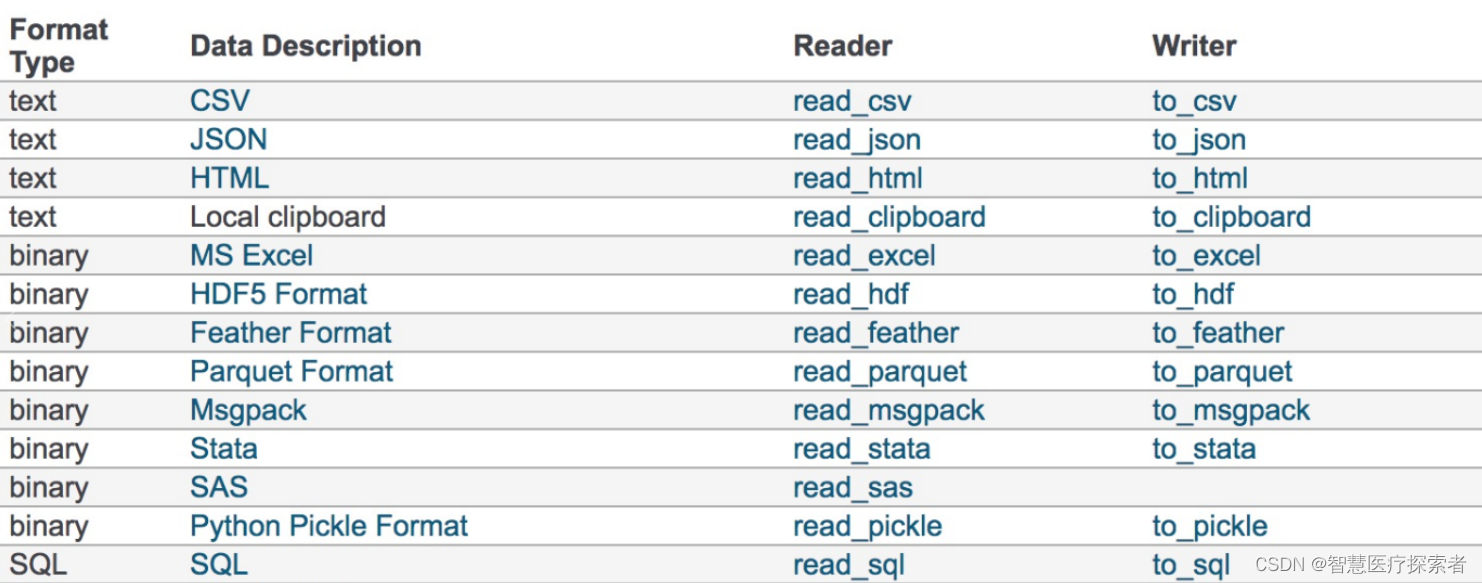
Pandas 提供了许多函数来加载数据,主要有以下几个函数:
read_csv():从 CSV 文件加载数据read_excel():从 Excel 文件加载数据read_sql():从 SQL 数据库加载数据read_json():从 JSON 文件加载数据read_html():从 HTML 文件加载数据
Pandas 提供了多种函数来将数据保存到不同的文件格式中,主要有以下几个函数:
to_csv():将数据保存到 CSV 文件中to_excel():将数据保存到 Excel 文件中to_sql():将数据保存到 SQL 数据库中to_json():将数据保存到 JSON 文件中to_html():将数据保存到 HTML 文件中
更多推荐
 已为社区贡献8条内容
已为社区贡献8条内容










所有评论(0)